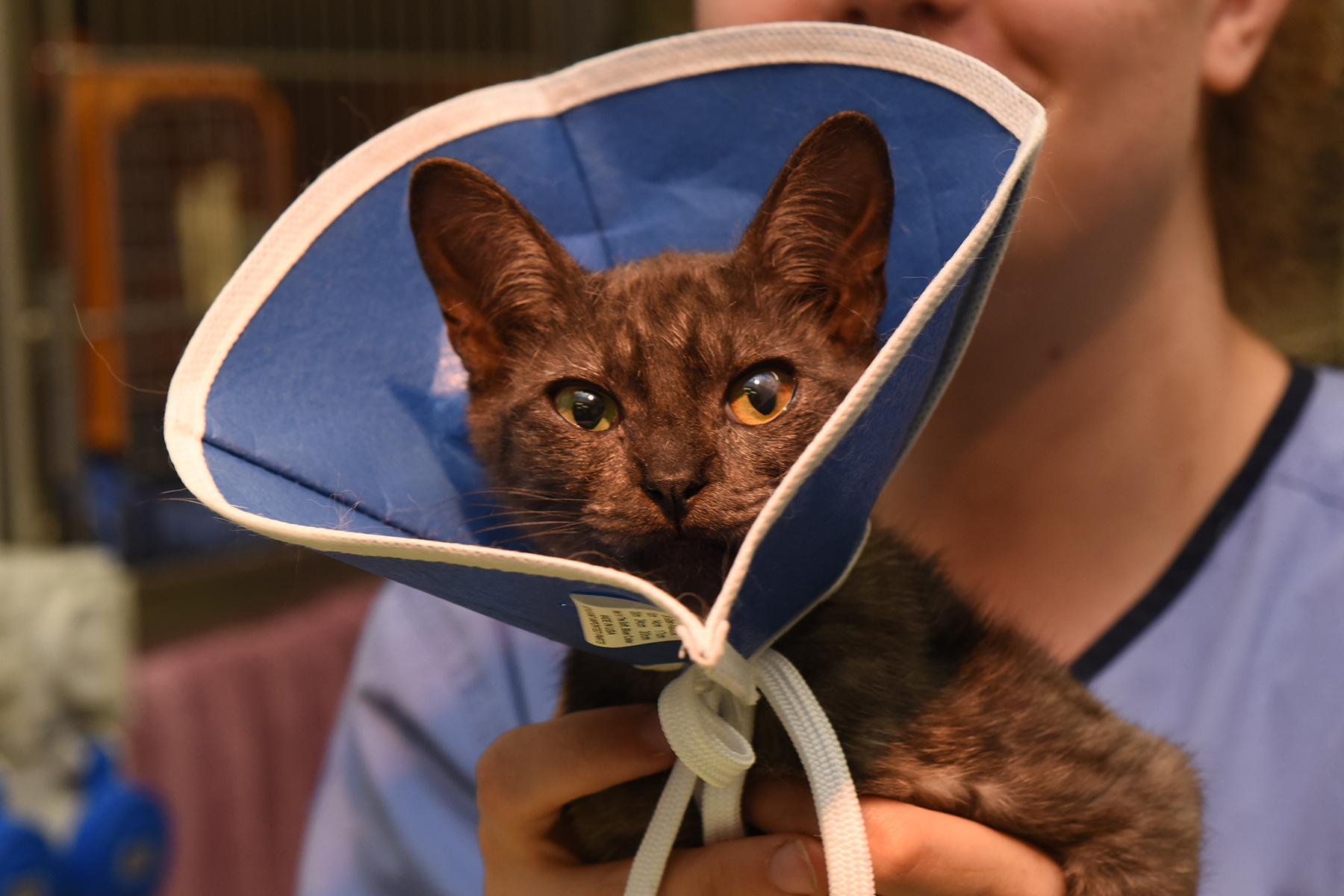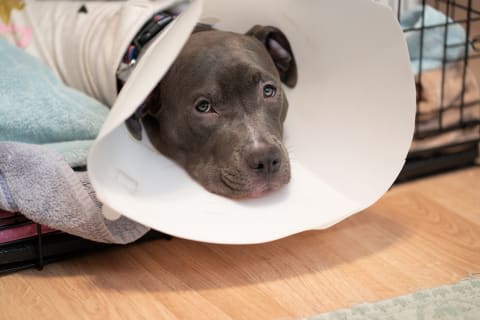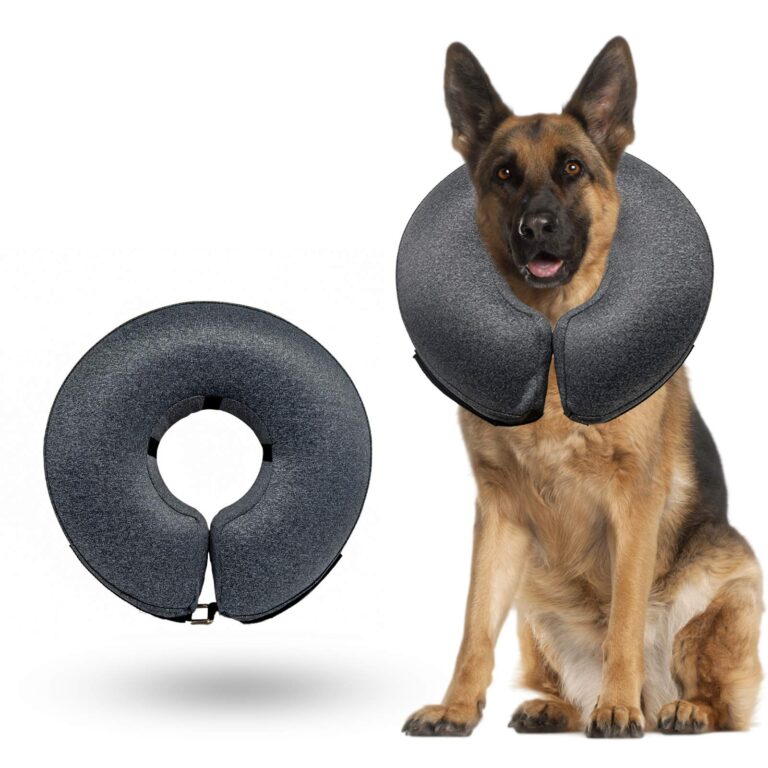Keep the cone on your dog after spay for as long as possible, including at night, and avoid removing it while they are sleeping. It may take some time for them to get used to wearing it, but it is important for their healing process.

Credit: www.sydney.edu.au
How Long Should The Cone Be Kept On?
Keep the cone on your dog after spaying as long as possible, even at night. Although it may be tempting to remove it for their comfort, cones are designed to protect the incision and should be worn until the wound is fully healed.
Expert Recommendations
When it comes to keeping the cone on your dog after spaying, expert recommendations vary. However, most veterinarians advise keeping the cone on for at least 7-10 days. It’s important to follow your veterinarian’s specific instructions, as they will consider your dog’s individual needs and recovery process. Keeping the cone on for the recommended duration is crucial for ensuring your dog’s safety and preventing any complications from occurring.
Factors That May Affect The Duration
Several factors can influence how long your dog should wear the cone after spaying. These factors include:
- Activity level: If your dog is highly active, it may be necessary to keep the cone on for a longer period to prevent them from engaging in behaviors that could disrupt the healing process.
- Breed: Certain breeds may require a longer duration of cone use due to their propensity for licking or chewing at the incision site.
- Individual healing rate: Each dog’s healing process is unique, and some may take longer to recover than others. In such cases, it may be necessary to extend the cone-wearing period as advised by the veterinarian.
Signs That The Cone Can Be Safely Removed
While it is essential to keep the cone on for the recommended duration, there are certain signs that indicate it may be safe to remove it:
- Incision healing: The incision site should show signs of healing, such as the absence of redness, swelling, discharge, and tenderness. It should also not require any additional assistance, such as sutures or staples.
- Behavior: If your dog no longer shows excessive licking, scratching, or attempting to remove the cone, it may be an indication that they are comfortable and the cone can be removed.
- Veterinarian’s approval: Always consult your veterinarian before deciding to remove the cone to ensure that your dog’s recovery is progressing as expected.
Remember, the cone is crucial for protecting your dog’s incision site and allowing it to heal properly. Removing the cone too early can lead to complications and delay the recovery process. It is always better to err on the side of caution and keep the cone on for the recommended duration determined by your veterinarian.

Credit: www.rock-hill.carolinavet.com
Tips For Ensuring Comfort And Safety
After spaying your dog, it is recommended to keep the cone on as long as possible, including at night. While it may take time for them to adjust to wearing it, avoiding removing the cone while they sleep helps ensure their safety and comfort during the healing process.
Choosing The Right Cone
When it comes to ensuring your furry friend’s comfort and safety after a spay procedure, choosing the right cone is crucial. The cone, also known as an Elizabethan collar or e-collar, prevents your dog from licking or chewing their surgical incision, which can lead to infection or delayed healing. Here are some tips to consider when selecting the right cone:- Measure your dog’s neck circumference: Use a measuring tape to determine the size of your dog’s neck. This will help you choose the appropriate cone size, ensuring a snug but comfortable fit.
- Consider alternative options: Traditional plastic cones can be uncomfortable for some dogs due to their rigid nature. If your dog seems distressed or uncomfortable in a plastic cone, consider alternatives like inflatable or fabric cones, which offer a more comfortable and flexible option.
- Consult your veterinarian: If you’re unsure about which type of cone to choose, don’t hesitate to consult your veterinarian. They can provide guidance based on your dog’s individual needs and preferences.
Helping The Dog Adjust To Wearing The Cone
Wearing a cone can be a challenging adjustment for dogs, causing them to feel uneasy and restricted. However, with some patience and simple strategies, you can help your pup adapt to wearing the cone more comfortably. Here are a few tips to assist your furry friend:- Introduce the cone gradually: Start by allowing your dog to sniff and explore the cone before gently placing it on their neck. This gradual approach can help reduce anxiety and confusion.
- Positive reinforcement: Reward your dog with treats, praise, and affection when they are calm and cooperative while wearing the cone. This will create positive associations and make them more comfortable.
- Supervise and distract: Monitor your dog during the initial stages of wearing the cone. Keep them engaged with interactive toys or puzzles to redirect their focus from the discomfort and make the adjustment period easier.
Monitoring For Any Complications Or Discomfort
While the cone is essential for your dog’s post-spay recovery, it’s crucial to monitor them for any signs of discomfort or complications. Regular observation will ensure their safety and well-being. Here are a few things to watch out for:- Excessive scratching or pawing at the cone: This could indicate that the cone is causing discomfort or irritation. Check for any redness or marks on the skin and consider adjusting the fit or trying a different type of cone.
- Difficulty eating or drinking: Some dogs may struggle to eat or drink with the cone on. Make sure they have easy access to food and water by using elevated bowls or placing their food closer to the edge of the cone.
- Changes in behavior: If your dog becomes unusually lethargic, anxious, or aggressive while wearing the cone, it could be a sign of distress. Consult your veterinarian to address any concerns promptly.

Credit: www.memphisveterinaryspecialists.com
Frequently Asked Questions On How Long To Keep Cone On Dog After Spay
Can I Take The Cone Off My Dog After 7 Days?
It is important to keep the cone on your dog for as long as possible, including at night. Avoid removing it while they are sleeping, as it may take time for them to get used to. Cones are designed to allow dogs to sleep normally and should be kept on until the designated timeframe, usually around 7 days after the spay surgery.
When Can I Remove My Dogs Cone After Spay?
Keep the cone on your dog after spay for 7-10 days to protect the incision. Avoid removing it while they sleep as it’s designed to let them rest comfortably. Check for healed incision, no redness, discharge, or tenderness, before removing the cone.
Can A Dog Sleep With A Cone On?
Yes, a dog can sleep with a cone on. Cones are designed to allow dogs to sleep normally. It may take some time for them to get used to it, but the cone should be kept on as long as possible, including at night.
How Do I Know If My Dog’s Spay Incision Is Healed?
A spay incision is healed when there is no redness, no need for staples or sutures, no tenderness, no discharge, and the incision area looks normal.
Conclusion
It is important to keep the cone on your dog after spaying for as long as possible, including at night. Although it may be tempting to remove it to help them sleep more comfortably, the cone is designed to protect the incision and prevent your dog from licking or scratching it.
Wait until the incision is fully healed, free of redness and discharge, and no longer tender to the touch before considering removing the cone. This will ensure proper healing and prevent any potential complications.



